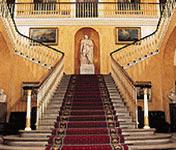“On the shoulders of Ridley”
Posted on 08/09/2006
“If I have seen further it is by standing on the shoulders of giants”
Sir Isaac Newton
This afternoon, in collaboration with UKISCRS and St. Thomas’ Hospital, Lonndon, Rayner hosted a seminar entitled “On the shoulders of Ridley” – a celebration – on the centenary of his birth – of the innovative genius of the late Sir Harold Ridley (1906-2000): his life and work and the subsequent development and future of his great invention, the intraocular lens.
Held in Governor’s Hall at St. Thomas’ Hospital, the location for the World’s first intraocular lens implant on 29th November 1949, the seminar was jointly chaired by Professors John Marshall and David J. Apple.
With many internationally renowned speakers, delegates were presented with a resumé of the development of the intraocular lens, the current status of the IOL and cataract surgery and an excellent insight into possible future technologies.
Professor David J. Apple (Salt Lake City, Utah, USA) gave an excellent and often moving account of the life and work of Sir Harold Ridley to mark his recent publication of Ridley’s definitive biography. He explained that without Ridley’s foresight, surgical skills and tenacity, it is likely that the IOL would never have evolved to become the major force it is today in modern cataract surgery.
In a thought-provoking presentation on the assessment of the quality of Vision by Mr. David J. Spalton (London, UK) said “Cataract surgery has changed from a sight-restoring operation to a refractive procedure and is changing again to a procedure to improve the quality of vision”, he explained. “Quality of manufacture, the quality of the optics and the quality of surgery are all important factors. In vivo MTF offers a great potential for characterising optical quality but dysphotopic symptoms remain a problem”.
Professor Gerd Auffarth (Heidelberg, Germany) gave a very interesting insight into the current opinions on posterior capsular opacification (PCO) which he considered to be “An important long-term complication of modern cataract surgery”. Professor Auffarth discussed the various influences on PCO formation, including IOL design and the concept of an Enhanced Square Edge to overcome the “Achilles’ Heel” of so many modern IOL designs, i.e. the absence of a square edge at the vulnerable optic-haptic junctions. He explained how Rayner’s development of this important concept culminated in the introduction of the C-flex® lens, having a marked improvement in PCO rates compared with other lenses. He emphasised that PCO is influenced not only by optic edge design but also by biomaterial and the interaction between capsule and IOL optic and that cataract surgery is rapidly developing into a refractive procedure including younger patients and the use of special IOLs. “PCO prevention is so important for the success and function of all new special IOLs“, he concluded.
Dr. Mark Packer (Eugene, Oregon, USA) gave a fascinating presentation entitled “Do aspheric optics make a difference?”. “Our results … indicate that IOLs with a spherical design implanted during cataract surgery do not achieve the natural compensation mechanism of corneal HOAs by internal structures of the eyes in young subjects”, he said.
Professor John Marshall (London, UK) then addressed the controversial subject of whether IOLs should have selective light transmission. During his presentation, he outlined the many varied and often contentious issues surrounding the concept of blue light-blocking IOLs.
“Multifocality in theory and practice” was the title of Mr. Paul Rosen’s(Oxford, UK) presentation. He emphasised that although multifocal IOLs have much to offer, it is important to consider the available options and select the correct lens on an individual patient basis. “Match patient and technology”, he said, and “Warn patients that they may need glasses and have haloes. Gain an informed consent and manage expectations”. Quoting Marcel Proust, Mr. Rosen concluded by saying, “The trouble with the future is that it usually arrives before we are ready for it”.
In his second presentation of the afternoon, Professor Auffarth introduced some new ideas on accommodative IOLs and explained that since the late 1980‘s there had been a continuing search for the restoration of accommodation in pseudophakic patients but it was not until the late 1990‘s that surgical techniques had sufficiently developed and suitable IOL materials had been introduced. “The ideal IOL should compensate for aphakia, restore accommodation and prevent PCO”, he said before giving delegates their first glimpse of a very exciting new development in IOL technology, the first implantation, on 28th June 2006, of a new toric multifocal IOL from Rayner.
Dr. Antonio Marinho (Porto, Portugal) presented “Are phakic IOLs the refractive choice of the future?”. He concluded that PIOLs will be used more and more in lower ametropias, as the rate of long term complications is reduced. “Until a real non-compromising accommodative/multifocal IOL is available”, he suggested, “PIOLs will remain the first choice for medium and high ametropias”.
The final presentation of the afternoon was by Dr. Sam Masket (Los Angeles, California, USA) who posed the question, “What lens will we be using in the future?”. “Truly accommodating IOLs are the hope for and the wave of the future as they are physiologic in concept and will likely have fewer optical side effects as compared with pseudo-accommodating IOLs”, he said. “Other IOL features for the future will likely include asphericity, adjustability, toricity and incorporate a means to alter post-operative reactions of the LECs”.
The event was very well attended and many congratulatory comments received, with the concensus being that it had been a most enjoyable and informative afternoon.
The Rayner-UKISCRS Dinner
On the evening of Friday 8th September, the Rayner-UKISCRS Dinner was held in the opulent surroundings of the magnificently appointed Institute of Directors Building, Pall Mall, London, UK The dinner was well attended and was considered by all to be a great success, marking the end of a very memorable day which began with the “On the shoulders of Ridley” meeting at St. Thomas’ Hospital.

